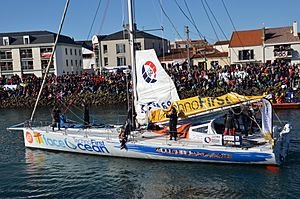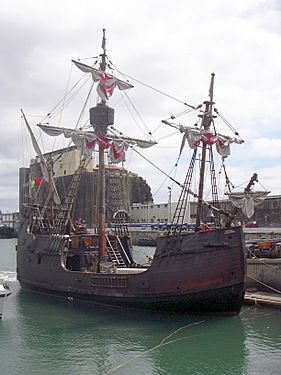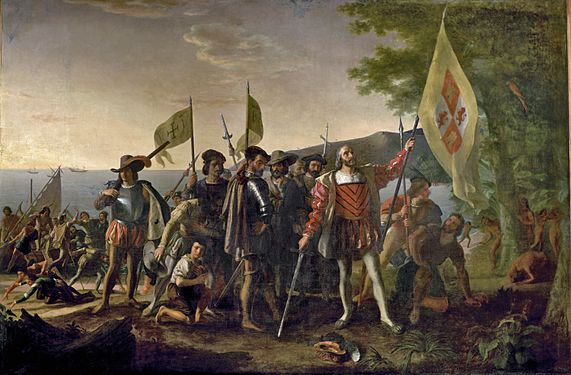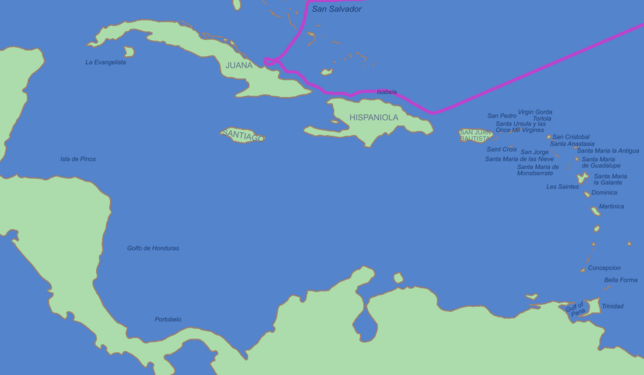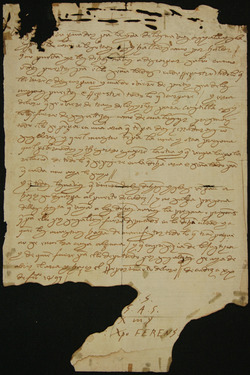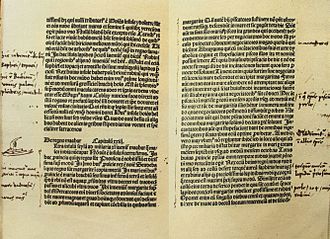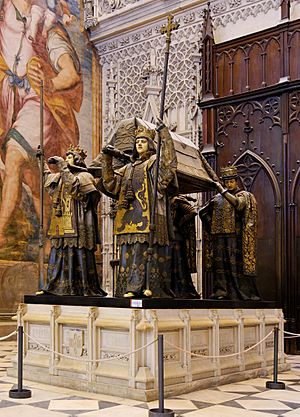Christopher Columbus facts for kids
Quick facts for kids
Christopher Columbus
|
|
|---|---|

Portrait of Christopher Columbus by Sebastiano del Piombo
|
|
| 1st Governor of the Indies | |
| In office 1492–1499 |
|
| Appointed by | Isabella I of Castile |
| Succeeded by | Francisco de Bobadilla |
| Personal details | |
| Born | Before October 31, 1451 Genoa, Republic of Genoa |
| Died | May 20, 1506 (aged c. 54) Valladolid, Castile |
| Resting place | Seville Cathedral, Seville, Spain |
| Spouse | Filipa Moniz Perestrelo |
| Domestic partner | Beatriz Enríquez de Arana |
| Children | Diego Fernando |
| Parents | Domenico Colombo Susanna Fontanarossa |
| Relatives | Brothers: Giovanni Pellegrino Giacomo (also called Diego) Bartholomew Sister: Bianchinetta Columbus |
| Occupation | Maritime explorer |
| Signature | |
| Military service | |
| Rank | Admiral of the Ocean Sea |
Christopher Columbus (1451–1506) was a Genoese trader, explorer, and navigator. He was born in Genoa, Italy, in the year 1451. "Christopher Columbus" is the English version of Columbus's name. His name in Italian was Cristoforo Colombo.
In 1492, Columbus sailed from Spain to find a faster route from Europe to Asia. He landed instead on an island of the Bahamas. He is credited with the discovery of the New World because Europeans began colonizing America shortly after his voyage. While Leif Erikson was the first European to land on the soils of America, it was not well documented and did not lead to the later contact between Europe and the New World.
When the Spanish learned that Columbus had found the New World, many other people, called conquistadors, went there too. This led to the Spanish colonization of the Americas.
Columbus died on May 20, 1506, in Valladolid, Spain.
Contents
Discovery of America
Columbus was not the first European person to have discovered America. At the time of his voyage, Europeans did not know that the Americas existed. However, Leif Erikson had landed in what is now Canada around AD 1000. Indigenous peoples had lived there for thousands of years before he arrived. However, Native Americans did not record or add to the European record of history, so Columbus discovered America according to European history.
Voyage in 1492
Many people in Western Europe wanted to find a shorter way to get to Asia. Columbus thought he could get to Asia by sailing west. He did not know about the Western Hemisphere, so he did not realize it would block him from getting to Asia.
However, Columbus did not have enough money to pay for this voyage on his own. He went to the rulers of Spain, Ferdinand II and Isabella I of Castile, to ask for help. He promised to bring back gold and spices for them, and they promised their help. After they defeated the Emirate of Granada, Ferdinand and Isabella paid for Columbus's voyage.
In August 1492, Columbus and his sailors left Spain in three ships: the Santa María (the Holy Mary), the Pinta (the Painted), and the Santa Clara (nicknamed the Niña: the Little Girl).
The three ships were very small. Historians think that the largest ship, the Santa María, was only about 60 ft (18 m) long, and about 16 to 19 feet (4.8 to 5.8 m) wide. Columbus's other ships were even smaller. Historians think they were about 50–60 ft (15–18 m) long.
Voyage
On October 12, 1492, after sailing for about four months, Columbus landed on a small island in the Bahamas. The natives called it Guanahani; Columbus renamed it San Salvador Island ("Holy Savior"). He met Lucayan, Taíno, and Arawak Native Americans who lived on the island. They were friendly and peaceful toward Columbus and his crew. Because Columbus did not know where he was, and thought he had reached Asia, the "Indies," he called them "Indians." He claimed their land as Spain's.
Columbus then sailed to what is now Cuba, then to Hispaniola. On Hispaniola, Columbus built a fort. This was one of the first European military bases in the Western Hemisphere. He called it Navidad (Spanish for "Christmas"). He left thirty-nine crew members there and ordered them to find and store gold.
Treatment of native people
On the day he landed in the Bahamas, Columbus wrote about the Arawaks and Taíno. He thought they would make good servants. He planned to take six of them with him when he left. He noticed that some of the Arawaks had gold earrings. He took some of them as prisoners and ordered them to lead him to the gold. However, they could not.
Second voyage
On September 24, 1493, Columbus left Spain with enough ships, supplies, and men to invade and make Spanish colonies in the New World. He had 17 ships and 1,200 men. These men included soldiers and farmers.
On this voyage, Columbus explored some of the Lesser Antilles islands. He also sailed around most of Hispaniola and explored the sides of Jamaica and Cuba he had not seen on his first voyage.
Then he went back to the Navidad fort and found the fort burned down. Eleven of the 39 soldiers Columbus left at the fort were buried there. The rest had disappeared. Historians think this happened because of disease and fights with the Arawak people.
Treatment of native people
The soldiers that Columbus left at Navidad while he was exploring Jamaica and Cuba stopped working. They began stealing from the Arawaks. This made the Arawaks decide to fight back against the Spaniards. However, Spain had many weapons that the Arawaks had never seen, including steel swords, pikes, crossbows, dogs, and horses. It was easy for Spain to win fights against the Arawaks.
Columbus also took revenge against the Arawaks for killing his soldiers at Navidad. He made every native older than 14 give him a certain amount of gold every three months. If they could not pay the gold, people would be made into slaves.
There was not much gold on the parts of the island Columbus took over. Many Arawaks tried to run away from Columbus and his men. However, Columbus's soldiers used dogs to hunt them down.
Start of the transatlantic slave trade
In February 1495, Columbus started the transatlantic slave trade. He and his soldiers captured about 1,500 Taíno. 400 were let go, 600 were kept on the island as slaves to the soldiers, and 500 were sailed back to Spain. Of those 500, about 200 died during the trip, and half of the rest were very sick when they arrived. This was the first time people had ever been shipped across the Atlantic Ocean to be sold as slaves.
Third voyage
In 1498, Columbus set out to find a continent that King John II of Portugal believed was to the southwest of the Cape Verde islands. Columbus sent three ships straight to the West Indies (the Caribbean). He led another three ships: first to two Portuguese islands, then to the Canary Islands, then to Cape Verde. From Cape Verde, they sailed to the northern coast of South America and landed in Trinidad. He also explored part of South America and the islands now called Tobago and Grenada.
On August 19, 1498, Columbus returned to Hispaniola. He found that many of the Spanish settlers there were unhappy. They thought there would be more gold in the New World. Some had rebelled, and Columbus had them hanged. In 1499, Queen Isabella sent a man named Francisco de Bobadilla to Hispaniola. She gave him the power to do whatever he thought he should do. When he arrived in 1500, the first thing he did was to have Columbus arrested and sent back to Spain in chains.
Treatment of native people
When he was trying to make the Spanish settlers happy, Columbus started the Encomienda system in Hispaniola. He "gave" land, or even a whole village, to a Spanish settler. Any natives that were living on the land were forced to work for that Spanish settler.
Arrest and the last voyage
On August 23, 1500, Columbus was arrested in Hispaniola, now called Santo Domingo, for cruelty to natives and Spaniards. He was sent to Spain in chains in October 1500. He was released on December 12, 1500, and taken to court. Columbus had important friends, and the King restored his freedom. He was allowed to lead another voyage.
Columbus made a fourth voyage in 1502-1504. On this voyage, he explored the coast of Central America from Belize to Panama. In 1502, off the coast of what is now Honduras, a trading ship "as long as a galley" was encountered, filled with cargo. This was the first recorded encounter by the Spanish with the indigenous civilization of Mesoamerica.
Later Columbus was stranded on Jamaica for a year; he sent two men by canoe to get help from Hispaniola. In the meantime, he impressed the local population by correctly predicting an eclipse of the moon. Help finally arrived, and he returned to Spain in 1504.
Later life and death
In his later years, Columbus demanded that the Spanish Crown give him 10% of all profits made in the new lands, according to earlier agreements. His demands were rejected. His family later sued for part of the profits from trade with America, but ultimately lost about fifty years later.
On May 20, 1506, Columbus died of heart failure and arthritis in Valladolid, Spain, at the possible age of 54. He was still convinced that his discoveries were along the East Coast of Asia. Even after his death, his travels continued with his body first buried in Valladolid and then in Seville. The will of his son Diego, who was governor of Hispaniola, had the remains transferred to Santo Domingo in 1542. In 1795 the French took over, and the body was moved to Havana. After the war of 1898, Cuba became independent and Columbus's remains were moved back to Spain, to the cathedral of Seville. However, some claim that he is still buried in the cathedral of Santo Domingo.
Personal life
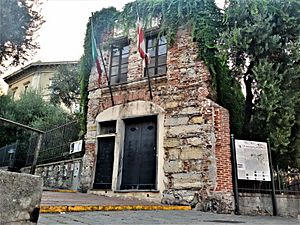
Columbus's relatives said that Columbus was born in Genoa, Italy. Today, no historian can say for sure where Columbus was born. Most experts think the best evidence says he was born in Genoa. However, other historians think Columbus was born somewhere else, like Spain or Portugal. His father was Domenico Colombo, a wool weaver who worked in Genoa and Savona and who also owned a cheese stand at which young Christopher worked as a helper. His mother was Susanna Fontanarossa. He had three brothers — Bartolomeo, Giovanni Pellegrino, and Giacomo (also called Diego) — and a sister named Bianchinetta. His brother Bartolomeo ran a cartography workshop in Lisbon for at least part of his adulthood.
His native language is thought to have been a Genoese dialect. His name in the 16th-century Genoese language was Cristoffa Corombo. His name in Italian is Cristoforo Colombo, and in Spanish Cristóbal Colón.
Columbus wrote that he first went to sea when he was 14 years old. In 1470, the Colombo family moved to Savona, where Domenico took over a tavern.
In 1477, Columbus married Felipa Moniz Perestrelo. She was from a semi-noble family with connections to sailing. She died around 1479 or 1480 while giving birth to their son, Diego.
In 1485, while in Córdoba, Spain, Columbus met Beatriz Enríquez de Trasierra. They lived together for a while. They had one child named Fernando. Columbus's first son Diego did not take care of Beatriz as Columbus had instructed him.
Being ambitious, Columbus eventually learned Latin, Portuguese, and Castilian. He read about astronomy, geography, and history, including the works of Claudius Ptolemy, Pierre Cardinal d'Ailly's Imago Mundi, the travels of Marco Polo and Sir John Mandeville, Pliny's Natural History, and Pope Pius II's Historia Rerum Ubique Gestarum.
Columbus's goals
Columbus journeyed to the New World with goals in mind. First, he believed he could find a shorter and easier route to Asia, which made things Europe did not. Some people said this was nonsense. Columbus wanted to prove these people wrong.
Second, Columbus wanted to find gold. Gold was the main kind of money used in Columbus's time. Many historians believe that Columbus wanted to become a powerful person – and to become powerful, he needed to find gold.
After Columbus
When the Spanish learned about the New World, many conquistadors, or conquerors, went there. This led to the Spanish colonization of the Americas.
The Spanish conquistadors first settled on the islands of Hispaniola (now the Dominican Republic and Haiti), Cuba, and Puerto Rico. They seized as much gold as they could.
Legacy
In the United States, Columbus Day is a holiday that celebrates Columbus's arrival in the New World on October 12, 1492. The World's Columbian Exposition, which happened in 1893 in Chicago, Illinois, was held to celebrate the 400th anniversary of Columbus visiting the Americas.
Many people do not celebrate Columbus Day due to his treatment of the Indigenous people. Many Columbus statues have been removed and parades discontinued, although it is still a federal holiday.
Interesting facts about Christopher Columbus
- The real name that he was given when he was born in Genoa was Cristoforo Colombo.
- Many people during the time of Columbus believed that the Earth was flat.
- Before his famous voyages, he used to sell maps and charts.
- The first land they saw in America was the island of San Salvador, 375 miles off of the coast of Florida.
- Columbus never actually set foot on what is now the territory of the United States.
- Seville Cathedral in Spain, and the Columbus Lighthouse at Santo Domingo in the Dominican Republic both claim to have Columbus's bones. In 2016 a DNA analysis said that the bones in Spain were his.
Christopher Columbus Quotes
- "You can never cross the ocean unless you have the courage to lose sight of the shore."
- "Following the light of the sun, we left the Old World."
- "Nothing that results in human progress is achieved with unanimous consent. Those that are enlightened before the others are condemned to pursue that light in spite of the others."
Related pages
Images for kids
-
Christopher Columbus House in Genoa, an 18th-century reconstruction of the house in which Columbus grew up. The original was likely destroyed during the 1684 bombardment of Genoa.
-
Toscanelli's notions of the geography of the Atlantic Ocean (shown superimposed on a modern map), which directly influenced Columbus's plans
-
"Columbus map", drawn c. 1490 in the Lisbon mapmaking workshop of Bartolomeo and Christopher Columbus
-
Columbus offers his services to the King of Portugal; Chodowiecki, 17th century
-
The Alhambra, where Columbus received permission from the Catholic Monarchs for his first voyage
-
Replicas of Niña, Pinta and Santa María sailed from Spain to the Chicago Columbian Exposition in 1893.
-
The Discovery of America sculpture, depicting Columbus and a cowering Indian maiden, stood outside the U.S. Capitol from 1844 to 1958.
-
Spanish Empire (red) in 1598, under Philip II, King of Spain and Portugal
-
Discovery of America, a postage stamp from the Faroe Islands commemorates the voyages of discovery of Leif Erikson (c. 1000) and Christopher Columbus (1492).
-
The Columbus Monument in Columbus Circle, New York City
-
Lighthouse in homage to Christopher Columbus in Santo Domingo
See also
 In Spanish: Cristóbal Colón para niños
In Spanish: Cristóbal Colón para niños


